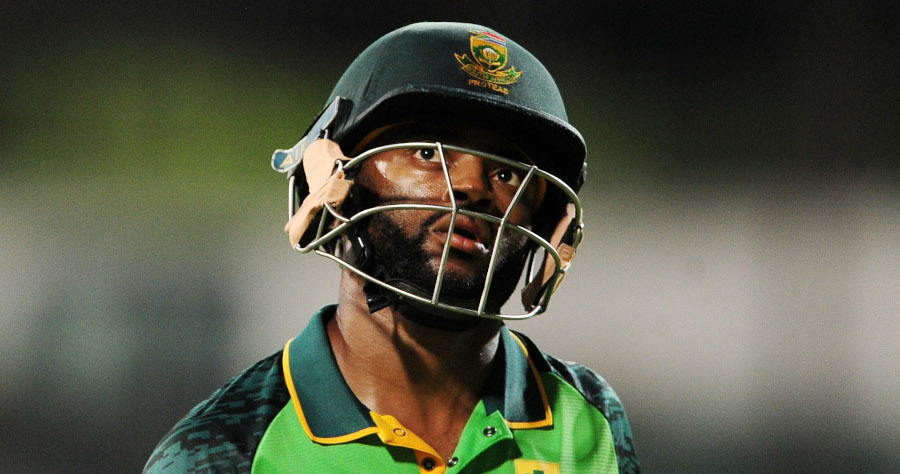The gulf between the potency and contributions of the Proteas bowlers and batsmen is widening by the game. With eight matches to go before the T20 World Cup, they urgently need to solve their skills, application and balance problems, writes RYAN VREDE.
On Tuesday the Proteas went 2-1 up against the West Indies, despite looking ordinary for significant chunks of the series to date.
They were pasted in the first match, but rebounded in the second and third, thanks largely to excellent bowling performances, after mediocre efforts with the bat.
In the wake of the second T20I, I wrote that the Proteas batters have serious skills deficiencies, many of which have been exposed by a skilful West Indies attack, who’ve exploited slow wickets to their benefit. The series’ third match did nothing to allay concerns about these deficiencies.
The Proteas have scored innings totals of 160-6, 166-7, 167-8, each time promising more, but ending well short of where they should have been.
Their PowerPlay totals have been: 53-1 (8.83 rpo), 69-0 (11.50) and 51-2 (8.50), which is on par, or in the case of the second match, exceeds the game’s average run rate in the PowerPlay for T20Is in the last year (7.95 rpo).
However, their skills deficiencies have resulted in them struggling to impose themselves in the middle overs. This has pressured them into taking risks their batters were technically incapable of without seriously compromising their wicket later in the innings. Consequently, they’ve finished poorly, scoring 28-4 in the last five overs of the second match, and 36-5 in the last five overs of the third.
Losing set top-order batsmen at critical times is a contributing factor. This was a feature of most matches to date, with Quinton de Kock getting 37 and 26 before his 72 in the third match, Reeza Hendricks with scores of 17, 42 and 17, and Temba Bavuma scoring 22 and 46 before a one in the third match.
It is self-evident that for the Proteas to amplify their challenge, they need at least one of their top three to bat deep (two exponentially increases the likelihood of a winning total). This becomes increasingly important on slow wickets, the likes of which the T20 World Cup in the UAE and Oman will be played on.
The inclusion of Faf du Plessis at No 3 could aid their ability to do this. He has excelled on the slow wickets of the IPL for two consecutive seasons, and has been a consistent performer for the Proteas in T20I cricket (averages 35.53 with a strike rate touching 136). However, it seems unlikely that he will be included in the squad for the World Cup given his unavailability for the Proteas, due to commitments with various T20 teams around the world.
Their middle to lower order is the primary concern, though.
A myriad combinations have been trialled and abandoned under head coach Mark Boucher. The likes of Jon-Jon Smuts, Pite van Biljon and, mostly recently, Heinrich Klaasen and Andile Phelukwayo have been ditched following a series of mediocre performances.
Aiden Markram, who has a career strike rate of 175, got a shot at No 4 on Tuesday, and looked good until a miscue was caught on the boundary. Markram will get further opportunities to entrench himself, and Boucher will hope he fills a piece of this perplexing puzzle.
Rassie van der Dussen has made himself hard to drop with a clutch of consistent performances. However, there are those who question whether the team has the luxury of accommodating a No 5 with strike rate of 139, especially when that delays the arrival of David Miller, who many believe should be batting higher in the order to set himself for a late-innings launch.
For now, it appears that a top six of De Kock, Reeza Hendricks, Bavuma, Markram, Van der Dussen and Miller will start the World Cup.
There is an argument for dropping a specialist batsman in that group, and going with two all-rounders at 6 and 7. A progressive approach would be to accommodate three, who would come from Dwaine Pretorius, George Linde, Phehlukwayo, Bjorn Fortuin and Wiaan Mulder, with Chris Morris a left-field option as well.
By virtue of the fact that Boucher and the selectors have gone with a team featuring six batsmen and five bowlers for the series to date (Markram and Hendricks were asked to make up some overs), it is likely that this is the balance they feel will serve them best at the World Cup.
If this is the case, Boucher, the batsmen and coaching staff need to urgently resolve the issues that have plagued them throughout the series.
With England and India (ranked first and second in the format, respectively) grouped with the Proteas, and just eight matches to go before the tournament starts, the clock is ticking on the Proteas’ prospects.
PROTEAS WORLD CUP WATCH: FOUR TEAMS, ONE GOAL
The Proteas are currently going with six specialist batsmen and five bowlers, which, with eight matches to go before the World Cup, is a strong indicator of their preference. However, there are alternative combinations they could explore. These are four on the table …
Current 6/5 split: De Kock, Hendricks, Bavuma, Markram, Van der Dussen, Miller, Linde, Rabada, Nortje, Ngidi.
A progressive 5/6 spilt: De Kock, Bavuma, Du Plessis, Miller, Markram/Van der Dussen, Pretorius, Linde, Rabada, Nortje, Shamsi.
A measured, dual all-rounder 6/5 split: De Kock, Hendricks, Bavuma, Markram, Van der Dussen, Miller, Pretorius, Linde, Rabada, Nortje, Shamsi.
A progressive, all-rounder heavy 5/6 split: De Kock, Bavuma, Du Plessis, Markram/Van der Dussen, Miller, Pretorius, Linde, Phehlukwayo/Fortuin/Mulder, Rabada, Nortje, Shamsi.
THE TEAM THAT WILL NEVER SEE THE FIELD [BUT MAY JUST WIN IT]
De Kock, Du Plessis, Markram/Van der Dussen, Miller, Pretorius, Linde, Morris, Rabada, Nortje, Shamsi, Tahir.







